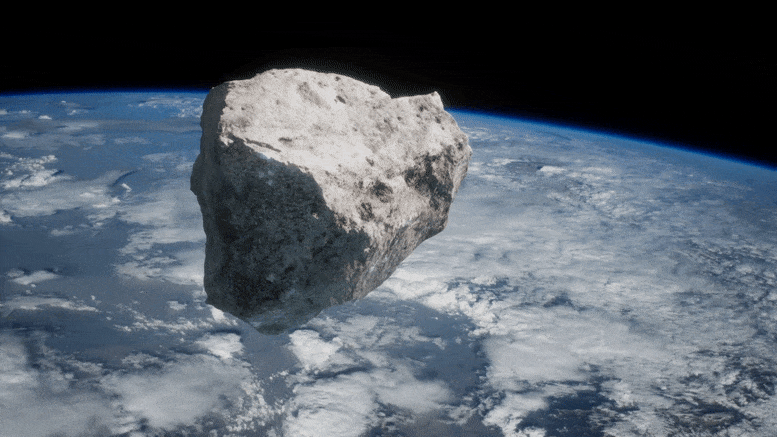
Illustration of asteroid approaching Earth
For a few tense days this January, a roughly 70-meter asteroid became the riskiest observed in over a decade. Despite the Moon’s attempt to scupper observations, the asteroid is now known to be entirely safe.
Initial observations of an asteroid dubbed ‘2022 AE1’ showed a potential Earth impact on July 4, 2023 – not enough time to attempt deflection and large enough to do real damage to a local area should it strike.
Worryingly, the chance of impact appeared to increase based on the first seven days of observations, followed by a dramatic week ‘in the dark’ as the full Moon outshone the potential impactor, ruling out further observations. As the Moon moved aside, the skies dimmed and ESA’s Near-Earth Object Coordination Centre (NEOCC) took another look, only to find the chance of impact was dramatically falling.
It has since been confirmed that 2022 AE1 will not impact Earth and has been removed from ESA’s risk list. So, what’s the story behind the excitement, and how can we trust this seemingly ‘meandering’ impact risk?
Never seen anything like it
“In January this year, we became aware of an asteroid with the highest ranking on the Palermo scale that we’ve seen in more than a decade, reaching -0.66,” explains Marco Micheli, astronomer at ESA’s NEOCC.
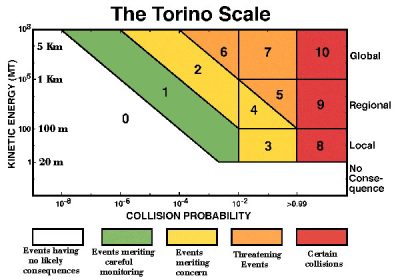
The Torino scale is a simplified version of the Palermo scale, used as a communication tool to illustrate the impact hazard of asteroids from a combination of their probability of impact and the energy they could strike with. Credit: ESA
“In my almost ten years at ESA I’ve never seen such a risky object. It was a thrill to track 2022 AE1 and refine its trajectory until we had enough data to say for certain, this asteroid will not strike.”
The Palermo scale is used by planetary defenders to categorize and prioritize the impact risk from near-Earth objects (NEOs) by combining the potential date of impact, the energy they would strike with, and the impact probability.
There are asteroids out there that will certainly hit Earth but are so small they are almost imperceptible as they burn up in our atmosphere. Others might be giant, extinction-level event asteroids which could do immense damage but are traveling in orbits around the Sun that are entirely safe.
Values less than -2 on the Palermo Scale reflect events with no likely consequences; those between -2 and 0 indicate situations that merit careful monitoring, and positive values generally indicate situations that merit some level of concern.
Planetary defenders – always alert
On January 7, one day after its discovery by the Catalina Sky Survey, asteroid 2022 AE1 was flagged for a potential future impact by the Asteroid Orbit Determination (AstOD) automated system that makes up part of the NEOCC’s suite of tools to assess the asteroid risk.
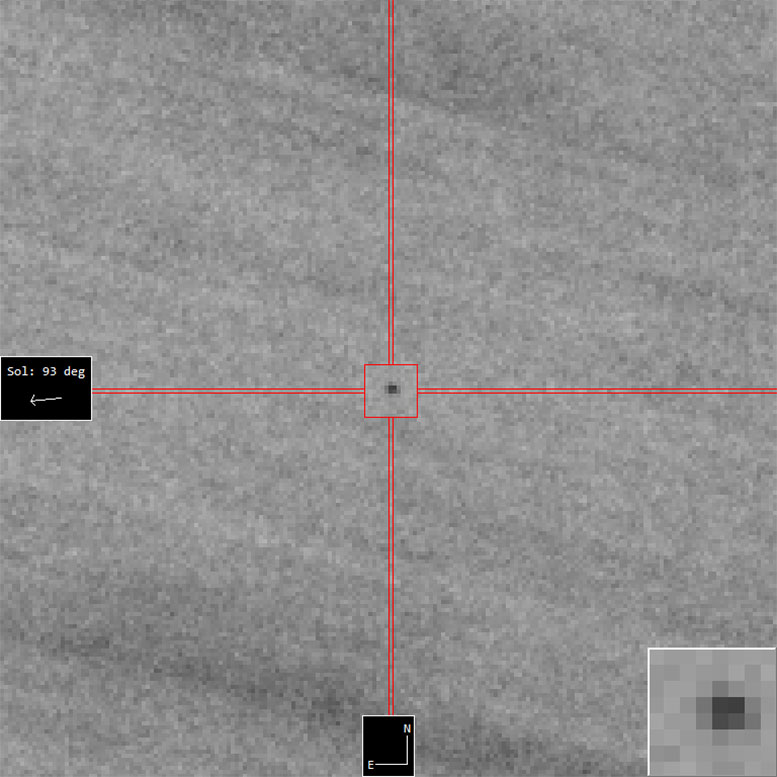
Asteroid 2022 AE1 observed with the Calar Alto Schmidt telescope in Spain on the evening of January 19, 2022. The image is a composite of 124 frames, each one minute long, combined on the motion of the asteroid, and processed in order to remove the background stars. The asteroid is visible as the dot at the center of the image, inside the red box. Stack produced using Tycho. Credit: ESA/NEOCC
Every day, the system automatically calculates the orbits from asteroid observation data provided by telescopes and observatories around the world. It then computes the Palermo Scale values, immediately publishing the results on the NEOCC web portal.
More risky cases – when asteroids are categorized as -2 or above on the Palermo Scale – are first cross-referenced with analysis from NASA JPL, to be extra certain of calculations before they’re published on the public page.
“I was surprised at first when I heard about this asteroid as it is very rare to have such high Palermo scale, at first rated -1.5. Yet, I wasn’t too concerned as we get notifications like this – though at a lower level – few times per year,” explains Luca Conversi, Manager of the NEOCC.
“As it is custom in these cases, we activated our global network of telescopes to immediately get more observations and it soon seemed this asteroid was unlike any other we’d seen.”
The Sun never rises on ESA’s eyes on the sky …
On the evening of Saturday, January 8, Marco ‘the impactor killer’ Micheli got hold of the 80 cm Schmidt telescope in Calar Alto, which the Coordination Centre has nearly continuous access to (weather permitting), to get more data.
“There’s no waiting till Monday when you’re back in the Office with this job,” explains Marco, whose role is to gather enough data on asteroids in ESA’s ‘risk list’ such that they can be deemed safe, at which point they are removed.
“But I love it, it’s part of the challenge. What makes this ‘detective work’ so much easier is that we have a network of telescopes on every continent that we can access in near real-time. It’s actually a unique capability of ESA which means it’s always night-time somewhere in our network, necessary to make asteroid observations.”
ESA continued to monitor the asteroid, verifying results with NASA JPL which confirmed a worrying increase in the large rock’s chance of impact. Unfortunately, as the probability of impact peaked, observations became impossible.
… until the Moon gets in the way
During a tense week over January 12-19, 2022 AE1 couldn’t be seen as the Moon outshone the dim potential impactor. On top of this, the asteroid was moving further away in its current orbit and getting fainter at the same time.
“We just had to wait,” says Marco.
Another one bites the dust
As soon as the Moon was dim enough, the NEOCC team pointed the Schmidt telescope at where 2022 AE1 was expected to be. With one single observation, the risk level crashed – getting close to zero – and with that, the team moved on.
“The data was clear, confirmed the next morning by our counterparts at NASA – asteroid 2022 AE1 poses no impact risk,” explains Laura Faggioli, near-Earth object dynamicist in the NEOCC who computed the orbit of 2022 AE1 throughout the observation period.
“Had 2022 AE1’s path remained uncertain we would have used any means possible to keep watching it with the biggest telescopes we have. As it was removed from our risk list, we didn’t need to follow it anymore – time to move onto the next.”
Although some keen observers have continued to monitor the asteroid, confirming results from ESA, we now know that in early July 2023, asteroid 2022 AE1 will fly by Earth at a distance of about ten million kilometers (+/- one million km) – more than 20 times the distance of the Moon.
Asteroids often look risky before they’re proven safe
It’s a funny thing about homing in on an asteroid and calculating its path, future position, and probability of impacting Earth – it will often appear risky during initial observations, get riskier, and then suddenly become entirely safe.
In the case of an asteroid on a definite collision course, the risk would keep growing until it reaches 100%. Fortunately, in most cases, the risk of impact ultimately flattens before rapidly getting down to zero – but why? Does this suggest our results are uncertain? Can we really be sure asteroid 2022 AE1 is safe?
The very first observation of an asteroid is ‘just’ a single dot of light in the sky. At this point, it’s not clear what it is or where it’s going. A second observation is needed to reveal an object in motion, at least three are needed to determine an orbit – how quickly our asteroid is going and where it is headed. Further observations refine the orbit a little more, reducing uncertainties until we can be sure of where it won’t go: primarily to Earth.
As is often the case, the overlap with Earth remains even while the risk corridor gets smaller due to further observations – and so the risk appears to increase.
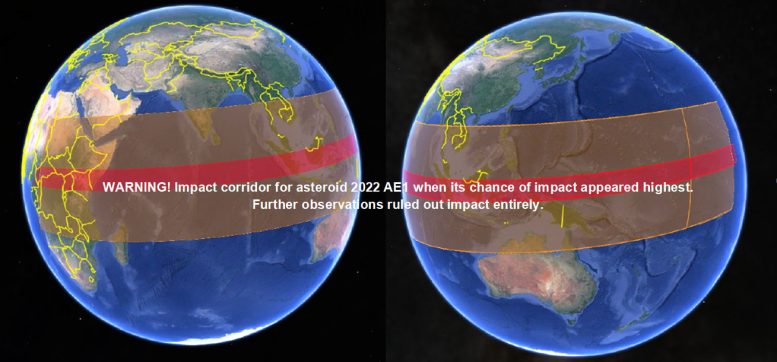
Initial uncertainties in asteroid 2022 AE1’s orbit meant its ‘risk corridor’ extended across Earth. When the 70-meter asteroid seemed most likely to impact (a scenario now ruled out entirely), its possible path saw a potential strike over many inhabited regions on Earth. The red region forms the core of the more probable impact points, the orange surrounding bands show areas that were less likely but could not be excluded. Credit: ESA
More often than not, as the hazard zone narrows, the small potential corridor moves off Earth and the risk suddenly drops. Even if some uncertainty remains about the path of an asteroid, we can know for sure it doesn’t pose a risk.
ESA’s Planetary Defence Office and Near-Earth Object Coordination Centre are now focussing on the next space rocks that could pose a threat, working with the international community to ensure that when an asteroid’s risk doesn’t drop, and an Earth impact looks likely, we are ready.

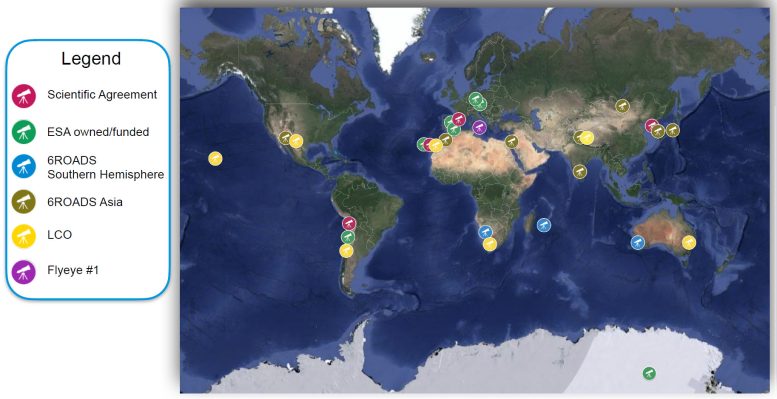
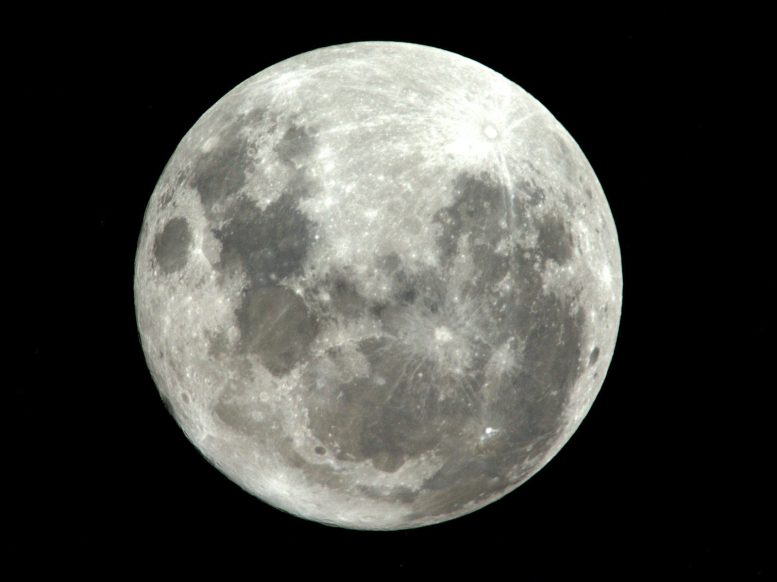
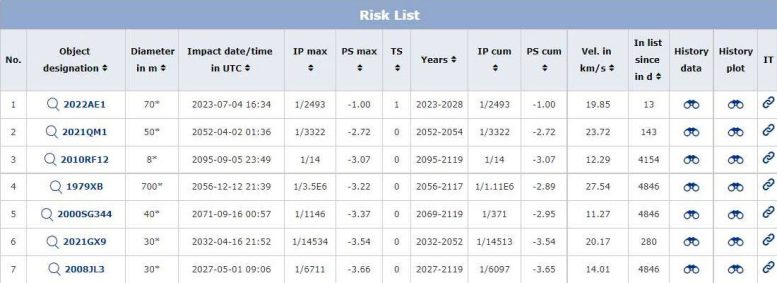
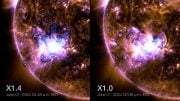
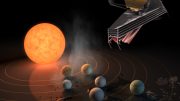
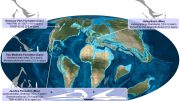


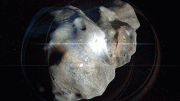

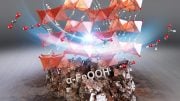
this was an excellent article – very informative. thank you
So it won’t impact?
Man, thats a bummer.
Dear Honorable
I always admired and respected God Creator of Creation Perfection in first place as GOD Omnipotence.
Secondly, always became concerned in meteorites coming to the earth as invisible ones by human kind, as deflection of rock space material unknown by human intelligence.
My concern is not the orbits of meteorites but the splitting of giant meteorites coming to the earth at the size that they are, human intelligence has no capacity to evaluate what own splitting of giant meteorites on space results from in their orbits, that large, medium and small rock pieces can come to the earth at a velocity speed that can not be controlled by human kind , their own trajectory.
My modest and humble thought as scientists predicted and very well, if big meteorites that risk the earth as observed, if they become smashed, who can control the rock pieces in the space orbits towards earth destruction of collision ?
Does the scientist evaluated the reason why exist so many meteorites of different sizes on the space orbits ? I believe that own decomposition or natural smashing happens or heat itself close to sun orbit proximity, so I congratulate the DART efficiency, in having decided to change the orbit of such big meteorite instead to destroy with nuclear explosion on space.
That will be biggest catastrophic result for all the humanity earth without being controlled how many rocks pieces will rise from such explosion in the space into the earth and solar system orbits itself .
If that will take effect, as nuclear explosion on space, then all Universe equilibrium of GOD Creation Perfection Omnipotence, will be affected. Thank You for having evaluated all scientific risks to the earth and having applied WISDOM more than INTELLIGENCY.
I hereby congratulate WISDOM that GOD Provides to Scientists more than Intelligency levels applied to save the earth and humanity, as super rationality intellect applied as required.
Congratulations to NASA Scientific Organization in all the world, as leaders of Space Technology for Centuries and Millenniums, God Willing.
Thank You all, for to save Humanity and Earth with God Providence of Wisdom Rationality of Intellect.
Praise God, as Nations of all Humanity for all His Providence to save His Creation, that we make part of His Infinit Universe unknown to human kind, as EARTH PLANET because are not Omnipotent like the Almighty Creator of us all also as His Divine Creation on Earth Planet and Universe of Space.
In God we trust ALWAYS as His Humanity Creation.
Highly Appreciated and thank You.
Maria Cristina Guttendorf Cipriano
IBA-International Business Assistance,Lda
Mozambique
Thank You NASA to save Humanity and Earth Planet timely, objectively and efficiently as all of You are.
In God we trust.
Maria Cristina Guttendorf Cipriano
IBA-International Business Assistance,Lda
Mozambique
Dear Honorable NASA,
I always admired and respected God Creator of Creation Perfection in first place as GOD Omnipotence.
Secondly, always became concerned in meteorites coming to the earth as invisible ones by human kind, as deflection of rock space material unknown by human intelligence.
My concern is not the orbits of meteorites but the splitting of giant meteorites coming to the earth at the size that they are, human intelligence has no capacity to evaluate what own splitting of giant meteorites on space results from in their orbits, that large, medium and small rock pieces can come to the earth at a velocity speed that can not be controlled by human kind , their own trajectory.
My modest and humble thought as scientists predicted and very well, if big meteorites that risk the earth as observed, if they become smashed, who can control the rock pieces in the space orbits towards earth destruction of collision ?
Does the scientist evaluated the reason why exist so many meteorites of different sizes on the space orbits ? I believe that own decomposition or natural smashing happens or heat itself close to sun orbit proximity, so I congratulate the DART efficiency, in having decided to change the orbit of such big meteorite instead to destroy with nuclear explosion on space.
That will be biggest catastrophic result for all the humanity earth without being controlled how many rocks pieces will rise from such explosion in the space into the earth and solar system orbits itself .
If that will take effect, as nuclear explosion on space, then all Universe equilibrium of GOD Creation Perfection Omnipotence, will be affected. Thank You for having evaluated all scientific risks to the earth and having applied WISDOM more than INTELLIGENCY.
I hereby congratulate WISDOM that GOD Provides to Scientists more than Intelligency levels applied to save the earth and humanity, as super rationality intellect applied as required.
Congratulations to NASA Scientific Organization in all the world, as leaders of Space Technology for Centuries and Millenniums, God Willing.
Thank You all, for to save Humanity and Earth with God Providence of Wisdom Rationality of Intellect.
Praise God, as Nations of all Humanity for all His Providence to save His Creation, that we make part of His Infinit Universe unknown to human kind, as EARTH PLANET because are not Omnipotent like the Almighty Creator of us all also as His Divine Creation on Earth Planet and Universe of Space.
In God we trust ALWAYS as His Humanity Creation.
Highly Appreciated and thank You.
Maria Cristina Guttendorf Cipriano
IBA-International Business Assistance,Lda
Mozambique
Thank You all, for to save Humanity and Earth with God Providence of Wisdom Rationality of Intellect.
I agree, let’s go Mozambique. SMH
I never sausage a risk! That would have been a great headline. Lol
Terrible article. How many times does it say the same thing over and over agai? It’s like someone had to fill it with so many words to get paid llololol
I hope and pray, with God’s intervention, it hits Moscow!
Regarding the projects to protect the Earth from asteroids.
As a PhD in physics and astronomy, I mean that there is a practically insurmountable problem for deflecting asteroids by any “impulse” method – both poorly consequences-controlled impact and using a relatively low-powered explosion (extremely-powered one is unacceptable due to a number of other known reasons). The matter is that almost all NEAs are not monolithic “rogue rock». Given the results of last direct study, it has become clear that they are essentially natural space debris, fragments of which are held together by gravity and cohesion – “flying gravel- rubble-boulder piles” (i.e. loose and crambly through and through, not just on the surface). Such internal structure will completely block momentum delivery to the asteroid as a whole, similarly to the perfectly inelastic collision. It is because that a shock wave arising from an impact/explosive (together with material escaping) decays and dissipates fast enough, wasting all its energy on heating and redistribution of different sized rock fragments.
Therefore, it is necessary to develop methods for a long-time and effective deflecting pressure on any hazardous object, which will allow to control and adjust the result of their action on the target. Since the gravitractor is weak at whole, being also affected only to individual asteroid fragments, and the laser method is not feasible due to the impossibility of cooling any powerful lasers in space, then the optimum way is use of high-focused solar energy. Practically it concern to orbital-built a specific and sufficiently sized solar-concentrating structure, which is ready to transportation toward the asteroid (or appropriate-sized comet nuclei) and operate – see:
https://link.springer.com/article/10.1007%2Fs11038-012-9410-2
as well as relevant section of the Wikipedia (“Asteroid impact avoidance – Use of focused solar energy”).
Lots of stupidity in the comments…